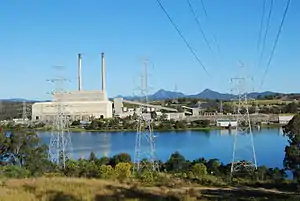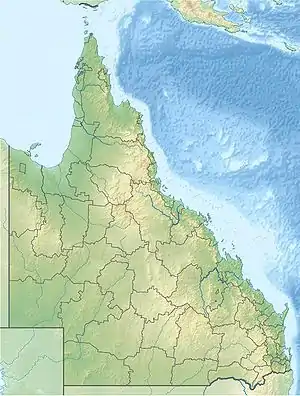Western Corridor Recycled Water Scheme
The Western Corridor Recycled Water Scheme, a recycled water project, is located in the South East region of Queensland in Australia. The scheme that is managed by WaterSecure is a key part of the SEQ Water Grid constructed by the Queensland Government in response to population growth, climate change and severe drought. The A$2.5 billion project is reported as the largest recycled water project in Australia.[1]
| Western Corridor Recycled Water Scheme | |
|---|---|
| Recycled water project | |
 Swanbank Power Station uses recycled water from the scheme. | |
 Location of the Western Corridor Recycled Water Scheme in Queensland | |
| Country | Australia |
| Location | South East Queensland |
| Coordinates | 27°32′54″S 152°32′48″E |
| Purpose | Recycle wastewater for industry and agriculture |
| Status | Operational |
| Construction began | 2006 |
| Opening date | November 2008 |
| Cost | A$2.5 billion |
| Operator(s) | WaterSecure |
| Total capacity | 232 ML (51×106 imp gal; 61×106 US gal) per day |
Location and features
The Western Corridor is the area from Brisbane's south west suburbs towards the city of Ipswich. For many years the corridor has experienced significant population growth with the development of the suburb of Springfield and the resultante extension of the Centenary Highway and the upgrade to the Ipswich Motorway.
The scheme involved the construction of three advanced water treatment plants constructed at Bundamba, Luggage Point and Gibson Island, which draw water from six existing wastewater treatment plants in the region to produce up to 232 megalitres (51×106 imp gal; 61×106 US gal) of purified recycled water daily.[2] The water is distributed via a network of pipelines measuring more than 200 kilometres (120 mi) in length. Construction began on the Recycled Water Project in 2006 and completed in late 2008.[3][4] A$408 million of funding was provided by the Australian Government via its Water Smart Australia Program.[5]
In Stage 1 of the project the scheme has provided an alternative water source for Swanbank Power Station and both Tarong Power Station and Tarong North Power Station. Supplies to Swanbank started in 2007 and supplies to Tarong and Tarong North started in June 2008.
The system has the capacity to provide water to other industrial users, agricultural users and to supplement drinking water supplies in Wivenhoe Dam. Testing of the pipeline to Wivenhoe Dam has been conducted, however in November 2008, Premier Anna Bligh declared that recycled water will not enter the dam unless levels drop to below 40%.[3] As of May 2009, the three power stations are the main customers of the recycled water, consuming 112 megalitres (25×106 imp gal; 30×106 US gal) per day.[3]
Since coming online in August 2007, through to July 2010, the Western Corridor Recycled Water Scheme has supplied more than 37 thousand megalitres (8.1×109 imp gal; 9.8×109 US gal) of water into the SEQ Water Grid.
In January 2013 it was reported that the Newman government was considering shutting down part or all of the scheme.[1]
References
- Walker, Jamie (21 January 2013). "Mothballs for Brisbane recycling scheme". The Australian. Retrieved 5 July 2014.
- "Western Corridor Recycling Plant". Department of the Environment. Australian Government. Retrieved 5 July 2014.
- Johnstone, Craig (8 May 2009). "Water recycling pipeline in mothballs". The Courier-Mail. Queensland. Retrieved 5 July 2014.
- "Western Corridor Recycled Water Project, Queensland". Key contracts and projects. Veolia Water. 2010. Retrieved 5 July 2014.
- "Final progress report Western Corridor Recycled Water Project: Stage 2". Department of Sustainability, Environment, Water, Population and Communities. Australian Government. 4 March 2010. Retrieved 14 October 2010.